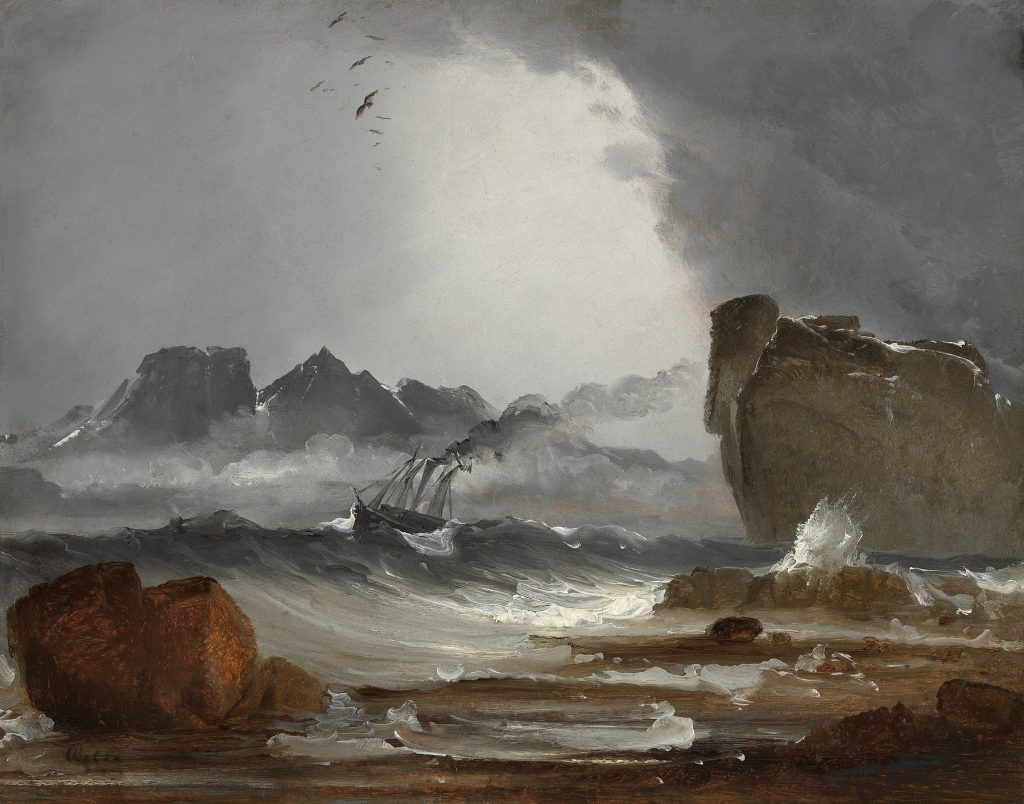Peder Balke (Hedemarken, Norway 1804 - 1887 Christiania)
Stormy Sea with a Steamer in Distress, c. 1850/55
Oil on paper, laid down on canvas, 33.5 x 42.5 cm
Signed lower left Balke
Provenance:
The artist’s estate
Thence by descent (the work remained in the family for three generations)
Grev Wedels Plass Aution, June 1993, Lot 21
Private collection, Norway
The Norwegian artist Peder Balke occupies a somewhat unique position in early nineteenth-century painting. The striking modernity of his work is widely recognized. Indeed, art historians now draw interesting comparisons with the work of Caspar David Friedrich and J. M. W. Turner.[1] A number of artists working today have reported finding his techniques intellectually stimulating.[2]
Balke’s landscapes draw their inspiration from the scenery of northern Norway, which he first experienced on a visit to Finnmark and the North Cape in 1832.[3] This journey was of central importance to his artistic development. The landscape motifs he recorded at the time are recurrent themes in his later work. The power and dramatic quality of his compositions reflect his first-hand experience of extreme weather conditions.
Balke’s aim is not topographical accuracy, despite his inclusion of familiar landscape subjects as background motifs. In their power and dramatic quality they have something of a metaphor about them: a ship battling against the violence of the storm-driven sea, a symbol for men frighteningly exposed to the dangers of the elements.
Balke received his early training in Norway. The absence of an academy of art caused him to leave the country in 1828 for Stockholm. In 1830 he visited Copenhagen where the paintings of J. C. Dahl impressed him greatly. In 1831 he embarked on his first journey to northern Norway. He visited the North Cape, first saw the midnight sun and experienced extreme weather conditions.
In 1835, after staying in Dresden for several months with Friedrich and Johan Clausen Dahl, Balke travelled on to Paris where he met his fellow countryman, the painter Thomas Fearnley. Both were particular admirers of Eugène Isabey, Théodore Gudin and Horace Vernet. As Marit Lange writes: The balance between a directly observed rendering of nature and a subjective, symbolic perception of it was to be a permanent feature of Balke’s art from then on.[4] Balke moved to Paris in 1844. He managed to obtain an audience with Louis-Philippe who had visited the north of Norway in his youth and was therefore eager to meet him. Balke showed the king the sketches of northern Norway he had brought with him to Paris and Louis-Philippe selected thirty to be worked up into paintings. Twenty-six of them are on permanent exhibition at the Louvre. Balke’s future as an artist seemed secure, but the unstable political situation in Paris put an end to the King’s plans and forced Balke to leave for London in 1849. He studied the work of Turner and this contributed to the growing radical tendencies of his style. By 1850 he was back in Norway. He joined a socialist worker’s movement and took on a number of social and political commitments. Despite his lack of public recognition as an artist, he continued to paint.
[1] Peder Balke 1804-1887, exhib. cat., Oslo, Kunstnernes Hus, 1954; P. Kvaerne and M. Malmanger (eds.), Un peintre norvégien au Louvre. Peder Balke (1804-1887) et son temps, Oslo, Instituttet for sammenlignende kulturforskning, 2006; Peder Balke. Ein Pionier der Moderne, exhib. cat., Kunsthalle Krems, 7.9.2008-15.2.2009 and Ordrupgaard Copenhagen, 5.3.2009-21.7.2009, Krems/Vienna/Bonn 2008. [2] Per Kirkeby, Peder Balke, Trick, Depth and Game, Hellerup 1996. [3] Finnmark is a region in the extreme north-east of Norway and borders on Russia. This is Norway’s only border with Russia. Balke’s journey took him from Trondheim to Vardø and Vadsø in the extreme east, via the North Cape. [4] P. Kvaerne and M. Malmanger, op. cit., p.35.

